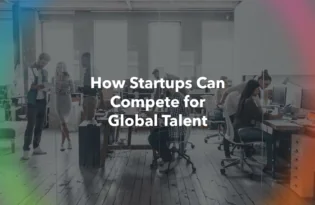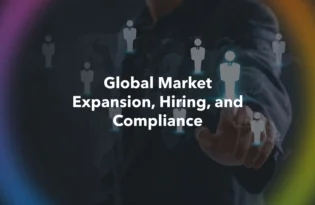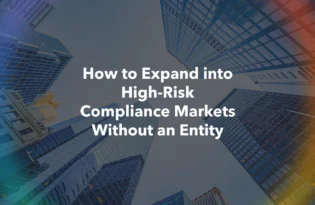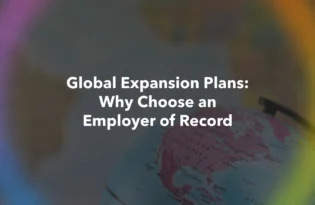CMS vs. EOR for Creative Roles: Balancing Speed, Cost, and Control
Creative agencies are no longer limited by geography. They are turning to global hiring solutions like CMS and EOR to access top talent. Each model offers unique benefits and challenges that impact cost, speed, and control. This article explores how to choose the right approach for building a world-class creative team.

Global Hiring is on the Rise, Especially for Specialized Talent
An agency’s best designer lives three time zones away. Does the agency lose them, or figure out how to keep them legally?
Forward-thinking agencies are no longer limited by geography; they are building distributed teams to access diverse skill sets, create around-the-clock production capabilities, and optimize labor costs.
Most importantly, they recognize that top talent and exceptional creative work can come from anywhere, enriching both the product and the culture. This global approach is a powerful competitive advantage.
However, it introduces a new layer of complexity. Each country has its own distinct legal territory, with unique rules governing employment, intellectual property, and worker classification.
For agency leaders, the challenge is clear: how to harness the power of a global creative team without getting entangled in legal and compliance issues that could derail growth?
What is a Contractor Management System (CMS)?
A Contractor Management System (CMS) is a software platform designed to help agencies organize and manage their freelance talent at scale.
These systems are invaluable for streamlining administrative tasks and improving operational efficiency, especially when working with a large roster of independent contractors.
A CMS typically helps businesses:
- Engage new freelancers and collect necessary documentation.
- Track project timelines, tasks, and deliverables.
- Manage invoices and process payments.
- Store contracts and project files in a centralized location.
Use Case: A CMS is an excellent tool for managing short-term or transactional creative engagements across many countries. It brings order to a high volume of freelance relationships, but its role is primarily organizational.
What is an Employer of Record (EOR)?
An Employer of Record (EOR) serves a fundamentally different purpose. An EOR is a legal partner that acts as the official, local employer for creative talent in another country. While companies retain full control over the creative direction, project management, and day-to-day work of the team, the EOR can handle the legal and administrative side of their employment.
This includes:
- Managing locally compliant payroll, including tax withholding and benefits contributions.
- Issuing employment contracts that adhere to local labor laws.
- Administering statutory benefits like paid leave, health insurance, and pensions.
- Allowing businesses to treat international creatives as integrated members of the team without the cost and complexity of setting up a local legal entity.
Use Case: An EOR is the best solution for engaging long-term contributors, core team members, or client-facing creatives who are deeply embedded in an agency’s operations.
CMS vs. EOR: What’s the Right Fit for the Creative Team?
Choosing between a CMS and an EOR depends entirely on the nature of the working relationship. One is built for managing temporary engagements, while the other is designed for building a permanent, compliant team.
| Criteria | Contractor Management System (CMS) | Employer of Record (EOR) |
|---|---|---|
| Best For | Short-term freelancers, task-based work | Longer-term team members, embedded creatives |
| Legal Compliance | Partial (helps organize docs, but you’re liable for legal compliance accuracy) | Compliance with local laws managed by EOR |
| IP & NDA Protection | Must be managed manually | Built into compliant employment contracts |
| Payroll & Taxes | The business manages contractor payments | EOR handles full payroll, tax withholding |
| Talent Retention | Limited control; no benefits or job security | Offers benefits, security, and higher retention |
| Cost Control | Potentially cheaper for small engagements | Higher cost, but reduced risk and stronger control |
| Speed to Onboard | Fast | Also fast, especially compared to entity setup |
When to Level Up from CMS to EOR
Many agencies begin with a CMS and “level up” to an EOR when project-based hiring meets its limit. Here are the key triggers that signal it’s time to consider an EOR:
- A contractor has become central to operations or client delivery. If their departure would create a significant business risk, they are no longer just a freelancer; they are a critical team member.
- A go-to designer is considering another offer with full benefits and paid leave. To compete for the best global talent, businesses need to offer the security of health insurance, paid leave, and other statutory benefits.
- Businesses concerned about misclassification or IP protection. If a contractor works regular hours under the direction of the business, the risk of misclassification is high. An EOR minimizes this risk and secures the company’s IP through locally enforceable contracts.
- An agency is building a distributed creative team, not just using freelancers ad hoc. To foster a true team culture with consistent performance and long-term alignment, create the structure of formal employment.
- Agencies want predictable cost, performance, and compliance across borders. An EOR provides a clear, consolidated cost structure and a single point of accountability for employment-related compliance.
How Payoneer Workforce Management Helps Agencies Expand, Compliantly and Efficiently
Payoneer offers a uniquely flexible Workforce Management solution because we recognize that modern agencies need both. Our platform provides EOR (Employer of Record) services for long-term, full-time team members and AOR (Agent of Record) services for independent contractors. This gives agencies the power to manage any type of global creative engagement, all within a single, trusted platform.
Imagine one centralized place that lets agencies:
- Hire talent in 160+ countries and territories without setting up legal entities.
- Handle employment contracts, statutory withholdings, and payments seamlessly.
- Have real-time visibility into team performance and payouts.
- Combine the operational ease of a CMS with the legal protection of an EOR.
Your creative talent shouldn’t be a compliance risk. Whether managing freelancers or building a global team, Payoneer Workforce Management gives you the speed, control, and legal peace of mind to scale creatively and compliantly.
FAQs
1) What is the fundamental difference between a CMS and an EOR for managing global creative talent?
A Contractor Management System is a software platform designed for administrative tasks, primarily for managing short-term, transactional freelance engagements. An Employer of Record is a legal partner designed for building a permanent, compliant team by acting as the official local employer for long-term contributors.
2) What are the key triggers that signal a creative agency should transition a worker from a CMS to an EOR solution?
An agency should transition to using an EOR when a relationship exposes them to higher risk or loss of talent. Key triggers include when a contractor becomes central to operations or client delivery, when the agency needs to offer statutory benefits like paid leave and health insurance to compete for top talent, or if there is concern about misclassification or IP protection.
3) How does using an EOR solution protect an agency’s intellectual property when hiring core creative team members abroad?
An EOR is crucial for IP protection because it issues locally compliant employment contracts that adhere to local labor laws. Unlike standard contractor agreements managed by a CMS, the EOR’s contracts have built-in IP assignment clauses that are legally enforceable, which helps secure the company’s proprietary creative work and assets. This is a core feature of the EOR services provided by Payoneer Workforce Management.
4) What is an Employer of Record (EOR)?
An Employer of Record (EOR) is a third-party organization that helps businesses engage and manage employees in other countries without setting up a local entity. Through an EOR, companies can manage payroll, benefits, and taxes more easily and help maintain compliance with local labor laws, while the company directs the employee’s daily work.
By partnering with an EOR, like Payoneer Workforce Management, businesses can expand into new markets efficiently, help reduce legal risks, and support the management of a global workforce.
5) What is the difference between a Contractor Management System (CMS) and an Agent of Record (AOR)?
A Contractor Management System (CMS) helps businesses manage contractor data, independent contractor agreements, and payments. An Agent of Record (AOR) is a service partner that supports the legal and administrative aspects of engaging contractors.
The CMS provides the tools to manage and track contractors, while the AOR helps engage, pay, and manage contractors correctly according to local requirements. Together, they create a streamlined and compliant way to manage a global contractor workforce.
Disclaimer
- Skuad Pte Limited (a Payoneer group company) and its affiliates & subsidiaries provide EoR, AoR, and contractor management services.
- The information in this article/on this page is intended for marketing and informational purposes only and does not constitute legal, financial, tax, or professional advice in any context. Payoneer and Payoneer Workforce Management are not liable for the accuracy, or reliability of the information provided herein. Any opinions expressed are those of the individual author and may not reflect the views of Payoneer or Payoneer Workforce Management. All representations and warranties regarding the information presented are disclaimed. The information in this article/on this page reflects the details available at the time of publication. For the most up-to-date information, please consult a Payoneer Workforce Management representative or account executive.
- Availability of cards and other products is subject to customer’s eligibility. Not all products are available in all jurisdictions in the same manner. Nothing herein should be understood as solicitation outside the jurisdiction where Payoneer Inc. or its affiliates is licensed to engage in payment services, unless permitted by applicable laws. Depending on or your eligibility, you may be offered the Corporate Purchasing Mastercard, issued by First Century Bank, N.A., under a license by Mastercard® and provided to you by Payoneer Inc., or the Payoneer Business Premium Debit Mastercard®, issued and provided from Ireland by Payoneer Europe Limited under a license by Mastercard®.
Related resources
Latest articles
-
Planning to hire employees in France? Here’s a quick guide
Looking to hire employees in France for your U.S. company? Learn about employment in France and how Payoneer Workforce Management makes it simple to hire in France.
-
Planning to hire employees in Spain? Here’s a quick guide
Are you looking to hire employees in Spain? Learn about employment in Spain and how Payoneer Workforce Management can help American companies hiring in Spain.
-
How to hire employees in the Netherlands
Looking to hire employees in the Netherlands for your U.S. company? Learn about employment in the Netherlands and how Payoneer Workforce Management can help hire in the Netherlands.
-
How to hire employees in Australia
Looking to hire employees in Australia for your US company? Learn about employment in Australia and how Payoneer Workforce Management makes it easy to hire in Australia.
-
Planning to hire employees in Germany? Here’s a quick guide
Are you looking to hire employees in Germany? Learn about hiring in Germany and how Payoneer Workforce Management can help U.S. companies hiring in Germany.
-
Planning to hire employees in the Philippines? Here’s a quick guide
Wondering how an American company hires employees in the Philippines? Our guide covers how to hire employees in the Philippines and how we can help.
Disclaimer
Nothing herein should be construed as if Payoneer Inc. or its affiliates are soliciting or inviting any person outside the jurisdiction where it operates/is licensed to engage in payment services provided by Payoneer Inc. or its affiliates, unless permitted by applicable laws. Any products/services availability are subject to customer’s eligibility. Not all products/services are available in all jurisdictions in the same manner. Depending on your eligibility, you may be offered with the Corporate Purchasing Mastercard, issued by First Century Bank, N.A., under a license by Mastercard® and provided to you by Payoneer Inc., or the Payoneer Business Premium Debit Mastercard®, issued and provided from Ireland by Payoneer Europe Limited under a license by Mastercard. The Payoneer Business Premium Debit Mastercard® cannot be used at merchants or ATMs in Hong Kong or for HKD payments. If you are located in the EEA, all Payoneer Services will be provided to you by Payoneer Europe Limited, trading as Payoneer and regulated by the Central Bank of Ireland.
The information in this document is intended to be of a general nature and does not constitute legal advice. While we have endeavored to ensure that the information is up to date and correct, we make no representations or warranties of any kind, express or implied, about the completeness, accuracy, reliability or suitability of the information. In no event will we be liable for any loss or damage including without limitation, indirect or consequential loss or damage, or any loss or damage whatsoever incurred in connection with the information provided.
















